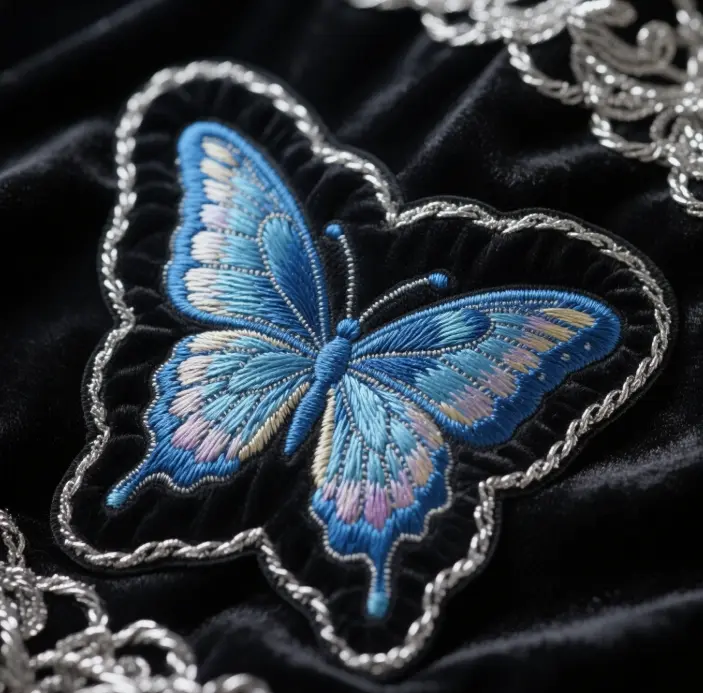Floral embroidery patch is a decorative element that fixes floral motifs onto fabrics by embroidery, which has been highly favored in the fashion industry and DIY crafts field in recent years. This article will delve into the definition, characteristics, market trends, usage techniques and applications of floral embroidery patches in different scenarios to help readers gain a comprehensive understanding of this unique decorative art.

Definition and Characteristics of Floral Embroidery patch
Floral embroidery patch is a form of embroidery, which utilizes a variety of fabrics to form a pattern on the backing, first paste it firmly, then use needle and thread to lock the embroidery along the patterned side of the pattern, to fix it, and carry out the detailed processing and become. This decorative method not only retains the artistry of traditional embroidery, but also adds the visual effect of fabric collage.

Main features
Variety of material choices: common floral embroidery stickers on the market are self-adhesive and iron-on, which are suitable for different fabrics and usage scenarios.
Rich pattern design: from traditional flowers (such as peony, lotus, plum blossom, bamboo, etc.) to modern simple geometric floral patterns to meet different aesthetic needs.
Wide range of applicable scenes: it can be used for decorating and repairing a wide range of items such as clothes (jackets, down jackets, T-shirts, shirts, cheongsams, etc.), bags, shoes, curtains and so on.
Handmade DIY Possibilities: in addition to purchasing finished products, enthusiasts can also make personalized floral embroidery stickers by DIY to express their personal creativity.
ds in the fashion world
Floral embroidery stickers are becoming more and more widely used in the fashion industry, especially in the following areas:
The return of Chinese elements: the combination of traditional embroidery techniques and modern clothing design, such as “with five-color fabric cluster into a four-way brocade” patch embroidery, “silk thread weaving text on the cloth” plain embroidery, etc., unique national characteristics.
Personalized customization demand growth: consumers are increasingly pursuing unique, personalized clothing, floral embroidery patch for this demand provides a simple and effective solution.
Integration of environmentally sustainable concepts: the use of fabric stickers for clothing repair, extending the service life of clothing, in line with the current environmental protection concept.
There are several main ways to use floral embroidery patches:
Ironing method:
- Align the transparent adhesive on the reverse side of the cloth sticker to the desired position.
- Lay a thin cotton cloth or handkerchief on top of the patch.
- Heat the iron with the steam setting for 20-30 seconds.
- Cool down to finish fixing
No iron alternative:
- Pour boiling water in a metal, flat-bottomed container (e.g., aluminum lunch box)
- Place it on top of the fabric patch and wait for some time (e.g. 10 minutes)
- Placing a heavy weight on top and pressing it down overnight can also complete the fit
Hand sewing method:
- Hand stitching along the edge of the fabric patch using a needle and thread
- Ideal for those looking for a stronger or more personalized effect
Cautions
- Fabric material selection: different materials may require different fixing methods, it is recommended to test in an inconspicuous place first.
- Temperature control: the temperature should not be too high when ironing, so as not to damage the fabric or cause deformation of the embroidery patch.
- The adhesive layer on the back of the fabric patch: make sure the adhesive layer is completely bonded, and the ironing time can be extended appropriately.
- Pre-treatment: for heavy fabrics, you can use scissors to make holes on the back of the fabric patch first, so that the heat of the iron can pass through.
DIY Making Methods
Basic materials and tools
Fabric: choose suitable base fabric and flower fabric, the base fabric is usually dark or monochrome fabric, and the flower fabric needs bright and colorful flower pattern fabric.
Embroidery tools: including embroidery bandage, embroidery needle, embroidery thread, scissors and other basic tools.
Auxiliary materials: such as water-canceling pens (for drawing patterns on cloth), cloth glue (for fixing patterns), etc.
manufacturing process
Pattern design and transfer:
Draw or choose a favorite floral pattern on paper
Transferring the pattern onto fabric (either by drawing directly with a water-based marker or by using copy paper)
Cut the fabric:
Cut the backing fabric and floral fabric according to the design pattern
Make sure the edges are flat and free of burrs
Fix the pattern:
Attach the patterned fabric to the base fabric using paste or fabric glue.
Make sure the pattern is flat and bubble-free
Embroidery fixing:
Use needle and thread to lock the embroidery along the patterned edges to secure the fabric to the backing.
Detailed embroidery can be added as required
Trimming and finishing:
Cut off excess fabric
Flatten with an iron to finish.



